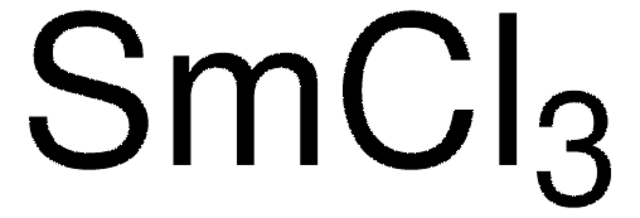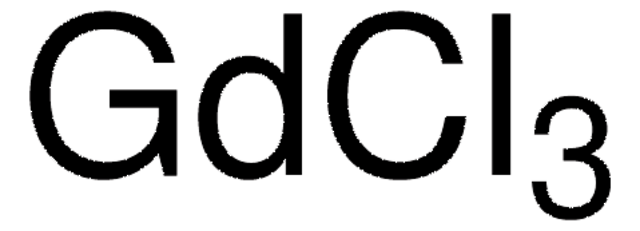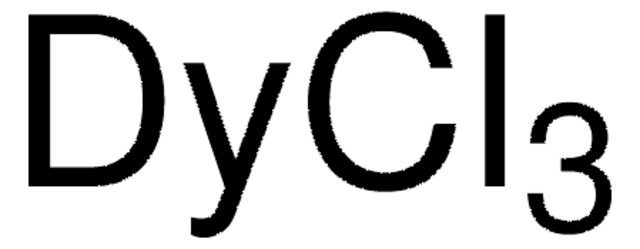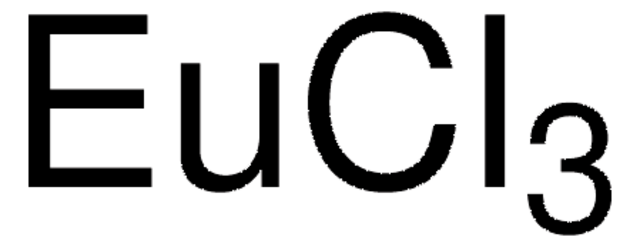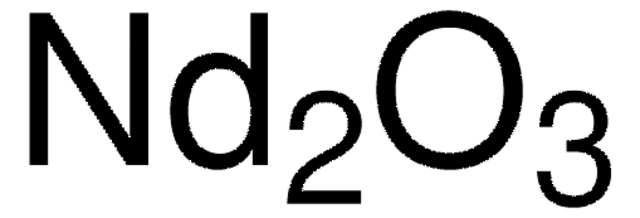Kluczowe dokumenty
449946
Neodymium(III) chloride
anhydrous, powder, ≥99.99% trace metals basis
Synonim(y):
Neodymium chloride, Neodymium trichloride
About This Item
Polecane produkty
klasa czystości
anhydrous
Poziom jakości
Próba
≥99.99% trace metals basis
Formularz
powder
przydatność reakcji
reagent type: catalyst
core: neodymium
zanieczyszczenia
≤100.0 ppm Trace Rare Earth Analysis
mp
784 °C (lit.)
gęstość
4.134 g/mL at 25 °C (lit.)
ciąg SMILES
Cl[Nd](Cl)Cl
InChI
1S/3ClH.Nd/h3*1H;/q;;;+3/p-3
Klucz InChI
ATINCSYRHURBSP-UHFFFAOYSA-K
Szukasz podobnych produktów? Odwiedź Przewodnik dotyczący porównywania produktów
Powiązane kategorie
Zastosowanie
- Fluorine-free organic electrolytes for the stable electrodeposition of neodymium metal: This study investigates alternative electrolytes for neodymium metal deposition, aiming for more sustainable battery manufacturing processes (Geysens et al., 2023).
- The use of artificial neural network (ANN) for modeling adsorption of sunset yellow onto neodymium modified ordered mesoporous carbon: Highlights the use of Neodymium(III) chloride in advanced adsorption processes for environmental applications, modeling the interactions using ANN (Ahmad et al., 2020).
wyposażenie dodatkowe
Hasło ostrzegawcze
Warning
Zwroty wskazujące rodzaj zagrożenia
Zwroty wskazujące środki ostrożności
Klasyfikacja zagrożeń
Eye Irrit. 2 - Skin Irrit. 2 - STOT SE 3
Organy docelowe
Respiratory system
Kod klasy składowania
11 - Combustible Solids
Klasa zagrożenia wodnego (WGK)
WGK 2
Temperatura zapłonu (°F)
Not applicable
Temperatura zapłonu (°C)
Not applicable
Środki ochrony indywidualnej
dust mask type N95 (US), Eyeshields, Gloves
Wybierz jedną z najnowszych wersji:
Masz już ten produkt?
Dokumenty związane z niedawno zakupionymi produktami zostały zamieszczone w Bibliotece dokumentów.
Klienci oglądali również te produkty
Produkty
The rare earth elements impact nearly everyone in the world. All of the people living in advanced technological countries and almost all those living in third world countries utilize the rare earths in their everyday living—the car that one drives (gasoline is refined from oil using rare earth catalysts and catalytic converters reduce the polluting emissions from the automotive exhaust), watching the news on TV (the red and green colors in TV screens), the telephones and computers we use to communicate (the permanent magnets in speakers and disc drives), just to name a few examples.
Nasz zespół naukowców ma doświadczenie we wszystkich obszarach badań, w tym w naukach przyrodniczych, materiałoznawstwie, syntezie chemicznej, chromatografii, analityce i wielu innych dziedzinach.
Skontaktuj się z zespołem ds. pomocy technicznej

